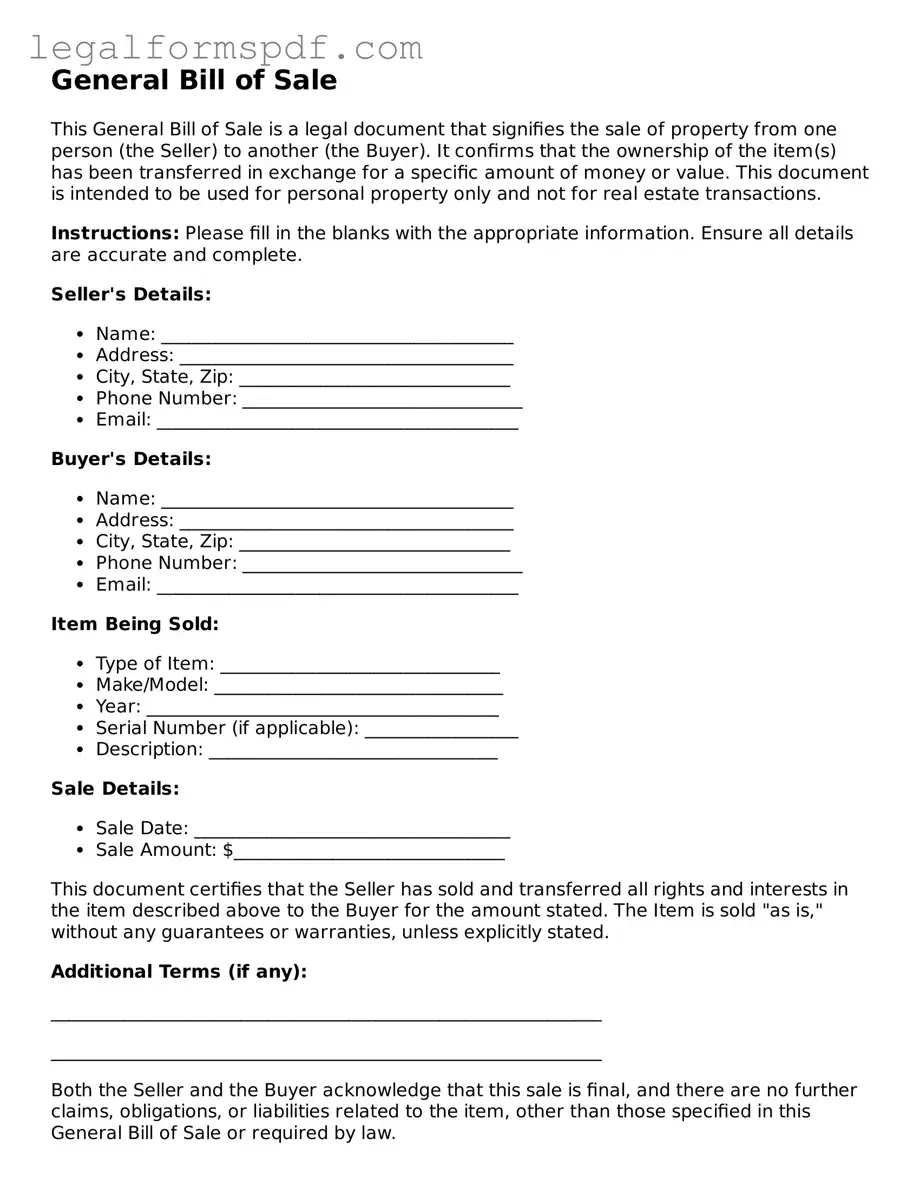A Warranty Deed is closely aligned with the General Bill of Sale in terms of its function to transfer ownership, but it is specifically used for real estate transactions. Unlike the General Bill of Sale, which is broad in application, a Warranty Deed contains guarantees from the seller to the buyer that the title to the property is free of liens or claims, providing an additional layer of protection for the buyer.
A Vehicle Bill of Sale is another document that resembles the General Bill of Sale, as it is used to document the sale and transfer of ownership of a vehicle from a seller to a buyer. Similar to the General Bill of Sale, it includes details about the sold item (in this case, a specific vehicle), the sale date, and the agreed-upon price. However, it is tailored to the nuances of vehicle transactions, often requiring additional information such as the make, model, year, and VIN (Vehicle Identification Number).
The Quitclaim Deed, like the General Bill of Sale, facilitates the transfer of ownership rights in property. However, it is distinct because it transfers any ownership interest the grantor may have without making any promises about the extent of their interest or the property being free from other claims. This makes it a less secure method of transferring property compared to the General Bill of Sale, which is usually used for goods where ownership is more straightforward.
The Promissory Note shares similarities with the General Bill of Sale in that it represents an agreement between two parties. However, instead of transferring ownership of goods, it outlines the details of a loan between a borrower and a lender, including the repayment schedule, the interest rate, and the consequences of non-payment. It is a financial document, whereas the General Bill of Sale is more transactional for physical or tangible items.
A Purchase Agreement is similar to the General Bill of Sale as it is used to document the sale of goods or property from a seller to a buyer. However, it is more comprehensive, often detailing the terms and conditions of the sale, warranties, and delivery instructions. It serves as a more detailed and binding contract between the parties, typically used in more complex transactions than those requiring a General Bill of Sale.
An Assignment Agreement can be compared to the General Bill of Sale as both involve transferring rights or interests from one party to another. An Assignment Agreement is specifically used to transfer contractual rights and obligations from one party to another, unlike the General Bill of Sale, which is used for the transfer of ownership of goods or personal property.
The Security Agreement is somewhat similar to the General Bill of Sale because it involves personal property. However, a Security Agreement is a document that provides a lender a security interest in a specific asset or property that is pledged as collateral for a loan, in case the borrower defaults on the loan. It is more about securing a debt rather than transferring ownership like the General Bill of Sale.
A Commercial Lease Agreement shares a tangential similarity with the General Bill of Sale in that both are agreements involving property. However, instead of facilitating the sale and transfer of ownership, a Commercial Lease Agreement outlines the terms under which one party agrees to rent property from another party for commercial purposes. It includes provisions regarding rent, the duration of the lease, and the use of the property.
A Stock Purchase Agreement is akin to the General Bill of Sale in that it also deals with the transfer of ownership, but it specifically pertains to the sale and transfer of stock or shares in a company from one party to another. The document details the number of shares being sold, the price per share, and any representations or warranties. It is a fundamental document in the realm of business finance and mergers and acquisitions.
Last but not least, a Power of Attorney document, while principally different, shares the basic premise of empowering another party to act on one's behalf. Unlike the General Bill of Sale, which transfers ownership of goods or property, a Power of Attorney grants another individual the authority to make decisions, which can include the sale of the owner’s assets, financial or medical decisions, depending on the type and scope of the document.
